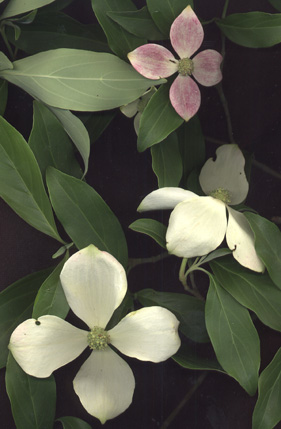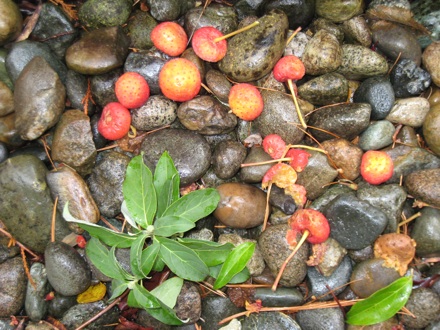Plant of the Month: June 2004
|
Evergreen Dogwood
|
Cornus capitata Wall. ex Roxb.
|
= Benthamidia capitata (Wall.) Hara
|
= Dendrobenthamia capitata (Wall.) Hutch.
|
CORNACEÆ; Dogwood Family
|
| The genus Cornus consists of 40 to 50 species, mostly shrubs, showing such diversity that some botanists split the genus into several separate genera. All species produce berry-like fruits. Unlike most woody plants, the leaves are almost invariably borne in opposite pairs and have distinctively curving veins. The flowers are tiny, greenish to yellow, but are sometimes surrounded by large, showy white or pink petaloid floral bracts of great visual appeal. |
| Cornus was the ancient Latin name of cornelian cherry, Cornus mas. The English name dogwood derives from Old English dagge, a dagger, skewer, or sharp pointed object. Some say the name came about because a mange cure for dogs was made from the bark of a shrubby species. |
| The North American native flowering dogwoods (C. florida and C. Nuttallii) are plagued by anthracnose fungal disease, caused by at least one species of Discula. As a result, the resistant East Asian Cornus Kousa has skyrocketed in popularity in recent years and there are a plethora of its new cultivars and hybrids. |
| The relatively little known Evergreen Dogwood deserves a bit of attention. I will share what I know of it. For years I had read about its performance elsewhere, but had seen none in Seattle. So I figured it was too cold-tender to grow here. Wrong assumption: time has shown that at least some specimens are hardy enough for some locations in Seattle. Cornus capitata has three or more subspecies, and there are hybrids of it as well. But I shall limit my remarks to typical Cornus capitata. It has been called: Evergreen dogwood, white evergreen dogwood, Himalaya strawberry-tree, and Bentham's cornel. |
| Native from the Himalayas to Indochina, this species was introduced from Nepal to England in 1825. It has been cultivated in California since the 1870s, and been in the nursery trade there ever since. It varies considerably in hardiness but cannot tolerate regions with prolonged freezes in winter, so is limited in its North American cultivation to the Pacific Coast --since the South is too hot for it. It is notably thirsty, so requires irrigation in Seattle and other dry-summer regions. |
| Unlike most species of Cornus, its foliage is evergreen, of a peculiar shade of dull, pale green above, gray-green beneath. Some of the oldest leaves turn tawny in November, and are reluctant to drop; most turn banana-peel yellow in late spring and drop easily. The leaves tend to droop, measure up to 5 inches long, up to 2 inches wide, and are coated with minute, closely appressed hairs that give them a rough texture when touched. |
| The flowers feature four (rarely six) rounded, dark creamy or yellowish petaloid bracts in June or early July. Sometimes the bracts fade to mauvy-pink. In bloom the tree is beautiful. The ensuing fruit is a compound headlike cluster of reddish berries, up to 2 inches wide, edible but not delectable; ripe in fall. The 1820 epithet capitata means headed; from Latin caput, head, referring to the moundlike heads of flowers and fruits. |
| It is shrubby, or a soft-textured small tree, often of great breadth. It has been recorded as high as 80 feet tall in the wild. In Western cultivation the largest may be in Ireland: 59 feet tall and the trunk 5.5 feet circumference, as of 1989, at Mount Usher, County Wicklow. In 1987 in California I bought a one-gallon plant, likely about 2 feet tall. Now it is 21.5 feet tall in my Seattle garden (27.5 feet as of April 2008. In December 2011, I cut in down.). It is not easily seen from the street. But another one-gallon specimen also planted in 1987 in Seattle is at the Good Shepherd Center (in Wallingford on Sunnyside Avenue N). That tree is not as tall as mine, is stouter, gets more sun and produces more fruit; its seeds are viable. I have noticed no self-sown seedlings from my tree (I found one in June 2008; many in 2009), though certain trees in irrigated California gardens do reseed. |
On balance I do not commend this species as an ornamental. Its flowers are no lovelier than those of certain of its cold-hardy relatives; its fruit display is matched by that of certain Cornus Kousa trees; its lack of fall color is not compensated for by its being evergreen; and its shedding of old leaves in late spring and early summer is messy.
Back
|

Cornus capitata flowers scan by ALJ
|

Cornus capitata fruit photo by ALJ
|
|
|

